module 39 Solar, Wind, Geothermal, and Hydrogen
After biomass and water, the most important forms of renewable energy come from the Sun and wind. These nondepletable sources of renewable energy represent the fastest growing forms of energy development throughout the world.
Learning Objectives
After reading this module, you should be able to
list the different forms of solar energy and their application.
describe how wind energy is harnessed and its contemporary uses.
discuss the methods of harnessing the internal energy from Earth.
explain the advantages and disadvantages of energy from hydrogen.
The energy of the Sun can be captured directly
450
In addition to driving the natural cycles of water and air movement that we can tap as energy resources, the Sun also provides energy directly. Every day, Earth is bathed in solar radiation, an almost limitless source of energy. The amount of solar energy available in a particular place varies with amount of cloudiness, time of day, and season. The average amount of solar energy available varies geographically. As FIGURE 39.1 shows, average daily solar radiation in the continental United States ranges from 3 kWh of energy per square meter in the Pacific Northwest to almost 7 kWh per square meter in parts of the Southwest.
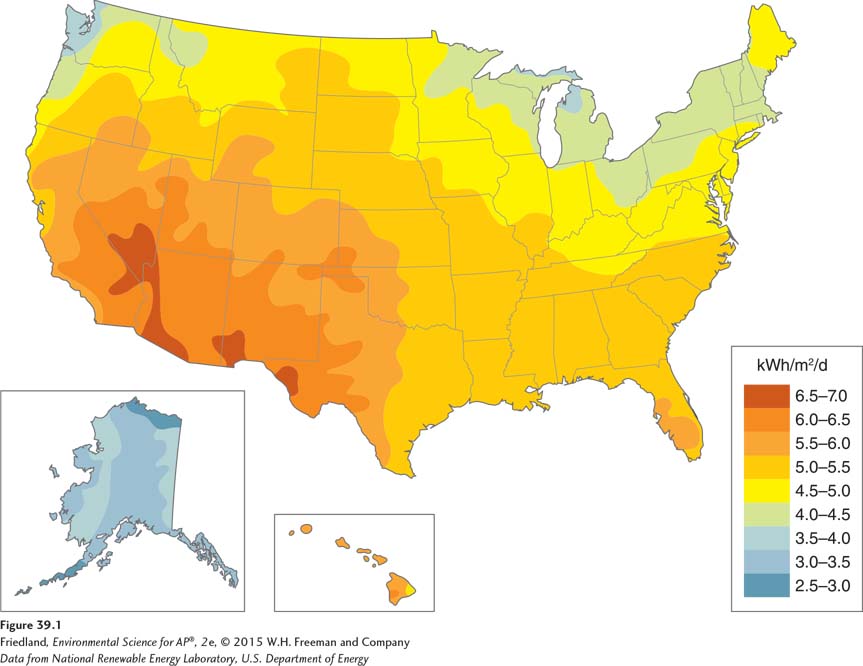
Passive Solar Heating
We have already seen several applications of passive solar heating, including positioning windows on south-
Solar ovens have both environmental and social benefits. The use of solar ovens in place of firewood reduces deforestation and, in areas unsafe for travel, having a solar oven means not having to leave the relative safety of home to seek firewood. For example, over 10,000 solar ovens have been distributed in refugee camps in the Darfur region of western Sudan in Africa, where leaving the camps to find cooking fuel would put women at risk of attack (FIGURE 39.2).
451
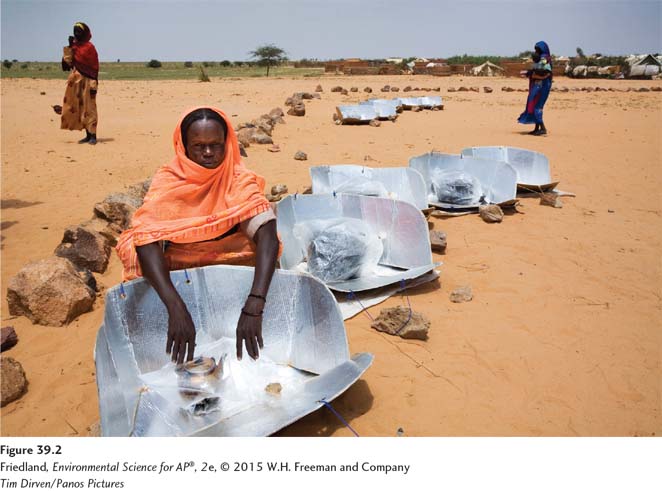
Active Solar Energy Technologies
Active solar energy Energy captured from sunlight with advanced technologies.
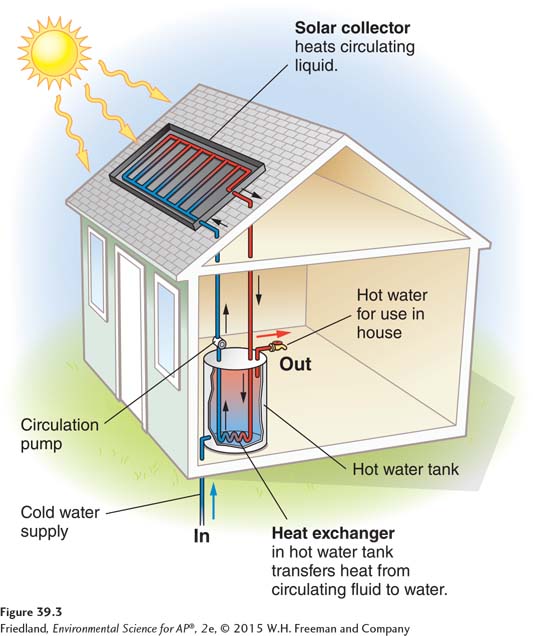
In contrast to passive solar design, active solar energy technologies capture the energy of sunlight with the use of technologies that include small-
Solar Water Heating Systems
Solar water heating applications range from providing domestic hot water and heating swimming pools to a variety of heating purposes for business and home. In the United States, heating swimming pools is the most common application of solar water heating, and it is also the one that pays for itself the most quickly.
A household solar water heating system, like the domestic hot water system shown in FIGURE 39.3, allows heat energy from the Sun to be transferred directly to water or another liquid, which is then circulated to a hot water heating system. The circulation of the liquid is driven either by a pump (in active systems) or by natural convection (in passive systems). In both cases, cold liquid is heated as it moves through a solar collector mounted on the roof or wall of a building or situated on the ground.

The simplest solar water heating systems pump cold water directly to the collector to be heated; the heated water then flows back to an insulated storage tank. In areas that are sunny but experience temperatures below freezing, the water is kept in the storage tank and a “working” liquid containing nontoxic antifreeze circulates in pipes between the storage tank and the solar collector. The nonfreezing circulating liquid is heated by the Sun in the solar collector, then returned to the storage tank where it flows through a heat exchanger that transfers its heat to the water. The energy needed to run the pump is usually much less than the energy gained from using the system, especially if the pump runs on electricity from the Sun. Solar water heating systems typically include a backup energy source, such as an electric heating element or a connection to a fossil fuel–
Photovoltaic Systems
452
Photovoltaic solar cell A system of capturing energy from sunlight and converting it directly into electricity.
In contrast to solar water heating systems, photovoltaic solar cells capture energy from the Sun as light, not heat, and convert it directly into electricity. FIGURE 39.4a shows how a photovoltaic system, also referred to as PV, delivers electricity to a house. A photovoltaic solar cell makes use of the fact that certain semiconductors—
Electricity produced by photovoltaic systems can be used in several ways. Solar panels—
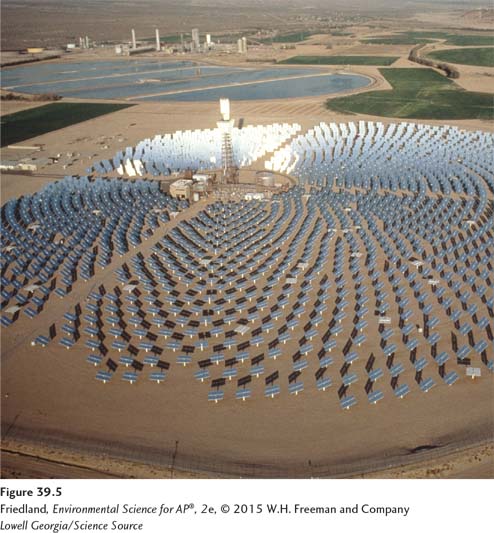
Concentrating Solar Thermal Electricity Generation
Concentrating solar thermal (CST) systems are a large-
Although CST systems have existed for 10 years or more, they are now becoming more common. In the United States, several plants are under development in California and in the Southwest. One 35 MW plant being planned in California calls for reflectors to cover 65 ha (160 acres) of land. These plants, though, have drawbacks that include the large amount of land required and their inability to generate electricity at night.
Benefits and Drawbacks of Active Solar Energy Systems
453
Active solar energy systems offer many benefits such as generating hot water or electricity without producing CO2 or polluting the air or water during operation. In addition, photovoltaic solar cells and CST power plants can produce electricity when it is needed most: on hot, sunny days when demand for electricity is high, primarily for air conditioning. By producing electricity during peak demand hours, these systems can help reduce the need to build new fossil fuel power plants.
In many areas, small-
Despite these advantages, a number of drawbacks have inhibited the growth of solar energy use in the United States. Photovoltaic solar panels are expensive to manufacture and install. Although the technology is changing rapidly as industrial engineers and scientists seek better, cheaper photovoltaic materials and systems, the initial cost to install a photovoltaic system can be daunting and the payback period is a long one. In parts of the country where the average daily solar radiation is low, the payback period can be even longer. Some countries, such as Germany, have made solar energy a part of their sustainable energy agenda by subsidizing their solar industry. In the United States, recent tax breaks, rebates, and funding packages instituted by various states and the federal government have made solar electricity and water heating more affordable for consumers and businesses.
The use of photovoltaic solar cells has environmental as well as financial costs. Manufacturing photovoltaic solar cells requires a great deal of energy and water and involves a variety of toxic metals and industrial chemicals that can be released into the environment during the manufacturing process, although newer types of these solar cells may reduce reliance on toxic materials. For systems that use batteries for energy storage, there are environmental costs associated with manufacturing, disposing of, or recycling the batteries, as well as energy losses during charging, storage, and recovery of electricity in batteries. The end-
Wind energy is the most rapidly growing source of electricity
Wind energy Energy generated from the kinetic energy of moving air.
The wind is another important source of nondepletable, renewable energy. Wind energy is energy generated from the kinetic energy of moving air. As discussed in Chapter 4, winds are the result of the unequal heating of the surface of Earth by the Sun. Warmer air rises and cooler, denser air sinks, creating circulation patterns similar to those in a pot of boiling water. Ultimately, the Sun is the source of all winds—
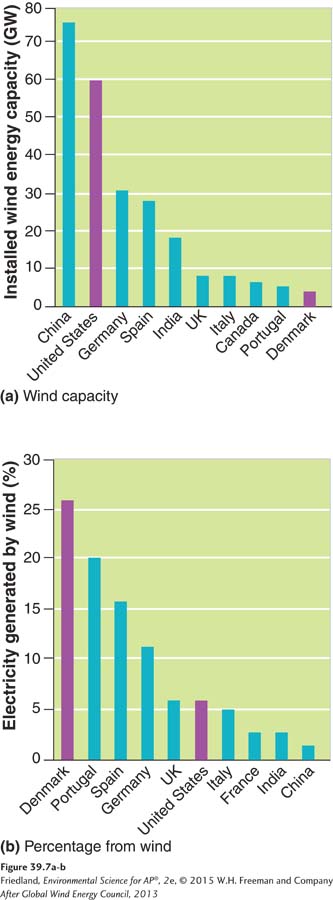
Before the electrical grid reached rural areas of the United States in the 1920s, windmills dotted the landscape. Today, wind energy is the fastest-
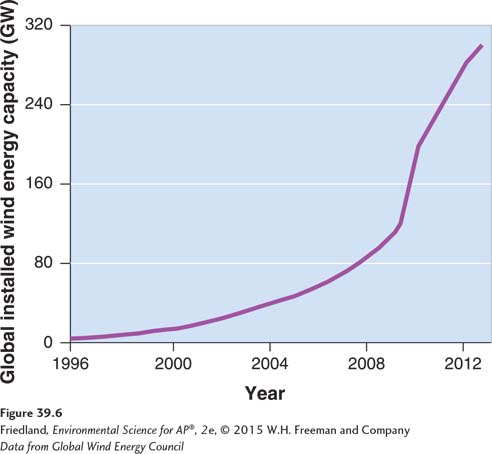
454
Despite its large generating capacity, the United States obtains less than 6 percent of its electricity from wind. The largest amounts are generated in California and Texas, although more than half of U.S. states produce at least some wind-
Generating Electricity from Wind
Wind turbine A turbine that converts wind energy into electricity.
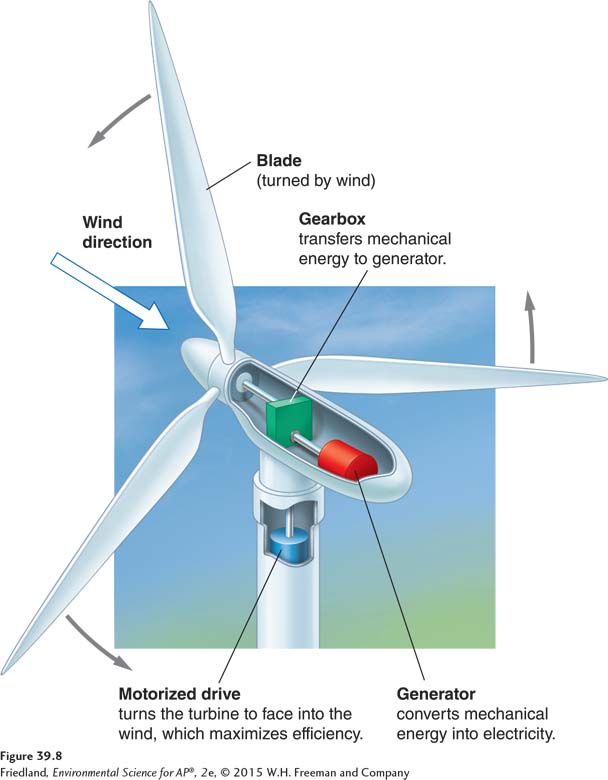
A wind turbine converts the kinetic energy of moving air into electricity in much the same way that a hydroelectric turbine harnesses the kinetic energy of moving water. As you can see in FIGURE 39.8, wind turns the blades of the wind turbine and the blades transfer energy to the gear box that in turn transfers energy to the generator that generates electricity. A modern wind turbine, like the one shown, may sit on a tower as tall as 100 m (330 feet) and have blades 40 to 75 m (130–
Wind turbines on land are typically installed in rural locations, away from buildings and population centers. However, they must also be close to electrical transmission lines with enough capacity to transport the electricity they generate to users. For these reasons, as well as for political and regulatory reasons and to facilitate servicing the equipment, the usual practice is to group wind turbines into wind farms or wind parks.
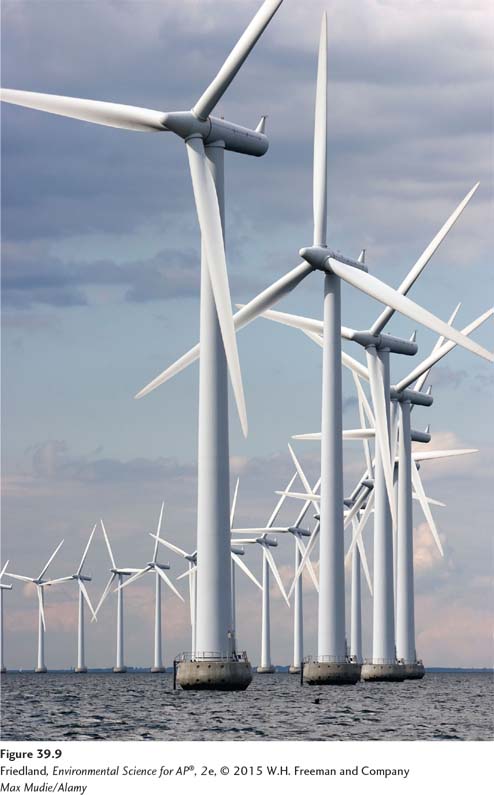
455
The number of wind farms is increasing in the United States and around the world. Wind farms are often placed on land in places where the wind blows up to 25 percent of the time. However, near-
A Nondepletable Resource
Wind energy offers many advantages over other energy resources. Like sunlight, wind is a nondepletable, clean, and free energy resource; the amount available tomorrow does not depend on how much we use today. Furthermore, once a wind turbine has been manufactured and installed, the only significant energy input comes from the wind. The only substantial fossil fuel input required, once the turbines are installed, is the fuel workers need to travel to the wind farm to maintain the equipment. Thus, wind-
Wind-
456
There has been resistance to wind farms in some regions of the United States. For example, the proposal that we mentioned to place a number of windmills in the waters off the coast of Cape Cod, Massachusetts, has languished as numerous hearings, protests, and court decisions have slowed development. In Vermont, a state often considered to be very environmentally friendly, more and more towns and individuals have argued against the installation of commercial wind projects on or near ridgelines, citing habitat fragmentation and alteration, noise, and aesthetics, among other reasons. Other states have slowed wind development by resisting the construction of electrical transmission lines, which also fragment habitat but are needed to move renewable electricity through forested areas.
Earth’s internal heat is a source of nondepletable energy
Geothermal energy Heat energy that comes from the natural radioactive decay of elements deep within Earth.
Unlike most forms of renewable energy, geothermal energy does not come from the Sun. Geothermal energy is heat that comes from the natural radioactive decay of elements deep within Earth. As we saw in Chapter 8, convection currents in Earth’s mantle bring hot magma toward the surface of Earth. Wherever magma comes close enough to groundwater, that groundwater is heated. The pressure of the hot groundwater sometimes drives it to the surface, where it visibly manifests itself as geysers and hot springs, like those in Yellowstone National Park. Where hot groundwater does not naturally rise to the surface, humans may be able to reach it by drilling.
Many countries obtain clean, renewable energy from geothermal resources. The United States, China, and Iceland, all of which have substantial geothermal resources, are the largest geothermal energy producers.
Harvesting Geothermal Energy
Geothermal energy can be used directly as a source of heat. Hot groundwater can be piped directly into household radiators to heat a home. In other cases, heat exchangers can collect heat by circulating cool liquid underground, where it is heated, and then returned to the surface. Iceland, a small nation with vast geothermal resources, heats 87 percent of its homes this way.
Geothermal energy can also be used to generate electricity. The electricity-
The heat released by decaying radioactive elements deep within Earth is essentially nondepletable in the span of human time. However, the groundwater that so often carries that heat to Earth’s surface can be depleted. As we learned in Chapter 9, groundwater, if used sustainably, is a renewable resource. Unfortunately, long periods of harvesting groundwater from a site may deplete it to the point at which the site is no longer a viable source of geothermal energy. Returning the water to the ground to be reheated is one way to use geothermal energy sustainably.
Iceland currently produces about 25 percent of its electricity using geothermal energy. In the United States, geothermal energy accounts for about 2 percent of the renewable energy used. Geothermal power plants are currently in operation in many states including California, Nevada, New Mexico, Oregon, Hawaii, and Utah. Geothermal energy has less growth potential than wind or solar energy because it is not easily accessible everywhere. Hazardous gases and steam may also escape from geothermal power plants, another drawback of geothermal energy.
Ground Source Heat Pumps
Ground source heat pump A technology that transfers heat from the ground to a building.
Another approach to tapping Earth’s thermal resources is the use of ground source heat pumps, which take transfer heat from the ground to a building by taking advantage of the high thermal mass of the ground. Earth’s temperature about 3 m (10 feet) underground remains fairly constant year-
FIGURE 39.10 shows how a ground source heat pump transfers heat from the ground to a house. In contrast to the geothermal systems just described, ground source heat pumps do not remove steam or hot water from the ground. In much the same way that a solar water heating system works, a ground source heat pump cycles fluid through pipes buried underground. In winter, this fluid absorbs heat from underground. The slightly warmed fluid is compressed in the heat pump to increase its temperature even more, and the heat is distributed throughout the house. The fluid is then allowed to expand, which causes it to cool and run through the cycle again, picking up more heat from the ground. In summer, when the underground temperature is lower than the ambient air temperature, the fluid is cooled underground and then pulls heat from the house as it circulates, resulting in a cooler house as heat is transferred underground.
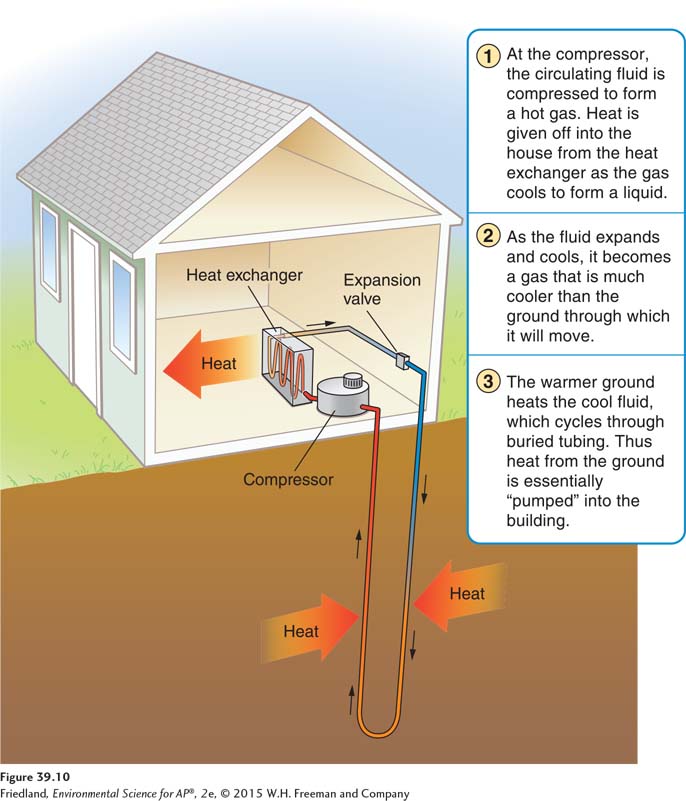
457
Ground source heat pumps can be installed anywhere in the world, regardless of whether there is geothermal energy accessible in the vicinity. The operation of the pump requires some energy, but in most cases the system uses 30 to 70 percent less energy to heat and cool a building than a standard furnace or air conditioner.
Hydrogen fuel cells have many potential applications
We end our coverage of sustainable energy types with one additional energy technology that has received a great deal of attention for many years: hydrogen fuel cells.
The Basic Process in a Fuel Cell
Fuel cell An electrical-
A fuel cell is an electrical-
458
FIGURE 39.11 shows how hydrogen functions as one of the reactants in a hydrogen fuel cell. Electricity is generated by the reaction of hydrogen with oxygen, which forms water:
2H2 + O2 → energy + 2H2O
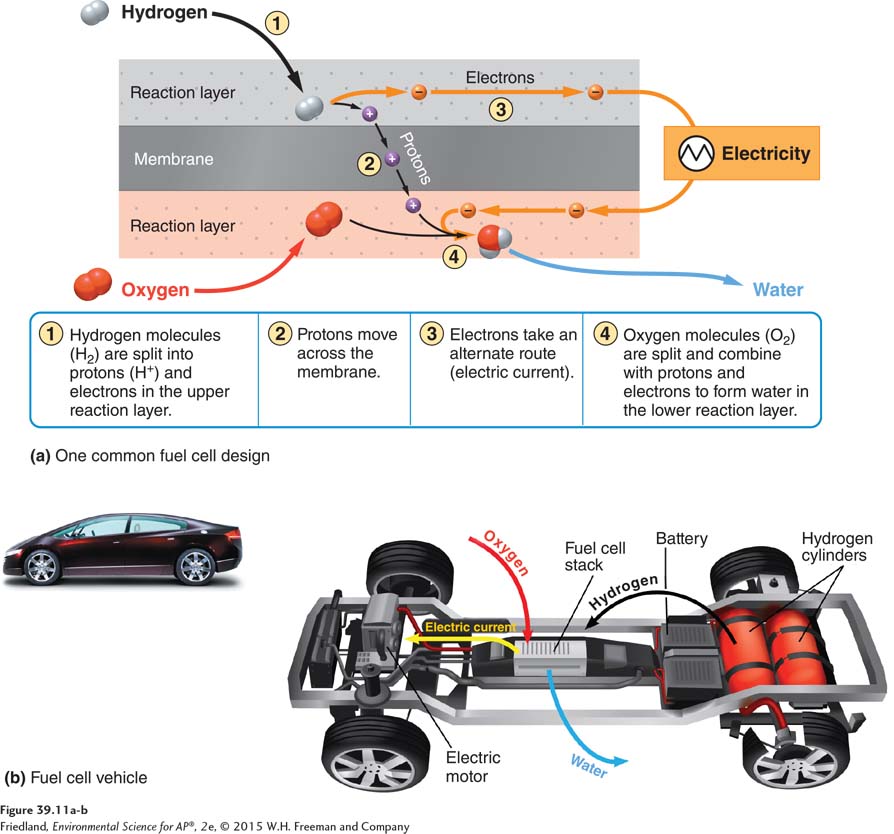
Although there are many types of hydrogen fuel cells, the basic process forces protons from hydrogen gas through a membrane, while the electrons take a different pathway. The movement of protons in one direction and electrons in another direction generates an electric current.
Electrolysis The application of an electric current to water molecules to split them into hydrogen and oxygen.
Using a hydrogen fuel cell to generate electricity requires a supply of hydrogen. Supplying hydrogen is a challenge, however, because free hydrogen gas is relatively rare in nature and because the gas is explosive. Hydrogen tends to bond with other molecules, forming compounds such as water (H2O) or natural gas (CH4). Producing hydrogen gas requires separating it from these compounds using either heat or electricity. Currently, most commercially available hydrogen is produced by an energy-
459
Although it may seem counterintuitive to use electricity to create electricity, the advantage of hydrogen is that it can act as an energy carrier. Renewable energy sources such as wind and the Sun cannot produce electricity constantly, but the electricity they produce can be used to generate hydrogen, which can be stored until it is needed. Thus, if we could generate electricity for electrolysis using a clean, nondepletable energy resource such as wind or solar energy, hydrogen could potentially be a sustainable energy carrier.
The Viability of Hydrogen
Some policy makers consider hydrogen fuel cells to be the future of energy and the solution to many of the world’s energy problems. Hydrogen fuel cells are 80 percent efficient in converting the potential energy of hydrogen and oxygen into electricity, with water as their only by-
Despite the many advantages of hydrogen as a fuel, it also has a number of disadvantages. First, scientists must learn how to obtain hydrogen without expending more fossil fuel energy than its use would save. This means that the energy for the hydrogen generation process must come from a renewable resource such as wind or solar energy rather than fossil fuels. Second, suppliers will need a distribution network to safely deliver hydrogen to consumers—
Given these obstacles, why is hydrogen even considered a viable energy alternative? Ultimately, hydrogen-